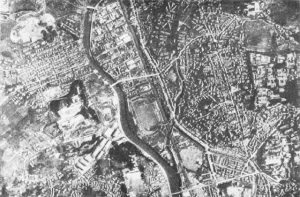Some of us may think that this question should already have a definitive answer, but the reality is that it is very difficult to answer in quantitative terms.
It is obvious that lightning is very powerful; we can see it in the destruction and losses caused by electrical storms. But what is the discharge produced?
Lightning generates temperatures above 20,000°C. This is much higher than that of lightning. This is much higher than that of the solar surface, which is approximately 6,000ºC.
A specific amount of energy is required to heat the air to such high temperatures. If we measure the length of the lightning and multiply it by the energy per meter needed to heat the air up to 20,000ºC, this energy can be calculated.
To get an idea, it is said that about 8 million lightning strikes a day and the energy produced is similar to 2 million tons of dynamite, about 100 times the atomic bomb of Nagasaki.

Photograph of Nagasaki before the atomic bomb.

Photograph of Nagasaki after the bombing.
Approximately, if lightning is about 5km long x 1cm wide, it can discharge between 1,000 and 10,000 million joules of energy, with a current of up to 200,000 amperes and 100 million volts.
This is why lightning is so lethal and why it is necessary to protect our homes, buildings, farms or businesses to prevent damage to people, animals, personal belongings or installations and machinery.
It is best to have your needs assessed by a specialized installer. To protect your home in the best way, quickly check your real risk with our risk index calculation or contact us.

